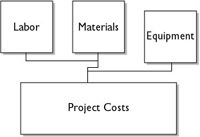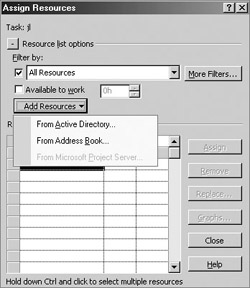Planning the Project Resources
|
| < Day Day Up > |
|
As part of the planning process, the project manager must determine what resources are needed to complete the project. Resources include the people, equipment, and materials that will be utilized to complete the work. In addition, the project manager must identify the quantity of the needed resources and when the resources are needed for the project. The identification of the resources, the needed quantity, and the schedule of the resources are directly linked to the expected cost of the project work, as shown here:

Consider a project to fully automate a new home: the lights, heating and cooling, appliances, and home security are all connected through a central computer operating system. The resources to complete the project work would include technicians, HVAC experts, electricians, and other people with the knowledge to install and configure the components. The resources in this case, however, would also include the network cabling to connect the components, diagnostic tools to monitor and test the installation, and the equipment and tools to physically install the components.
In addition, services and sites are considered resources as well. Your project may require a vendor's service, such as a commercial printer, a carpenter, or other service. If these services are not available for the project as planned, the project will suffer. Some projects require you to lease space; the leased space is considered a resource.
In some instances, it is most cost effective to hire a consultant or subject matter expert (SME) to identify details unique to the project work, such as mandates, laws, standards, and so on. The expense of relying on the SME may be far less than the cost of the time to research the unique details and requirements of the project. The knowledge gained from the SME can offset the expenses that would otherwise result from not having specialized knowledge of the project work.
Exam Watch
If time is an issue in a complex project, rely on an SME to provide input to the decision-making process. If the project team is lacking a needed project skill set, a seminar or training class is appropriate to get the team member up to speed.
Consider the Inputs to Resource Planning
Resource planning is the process of examining the project work and determining what resources, people, and equipment are needed to complete the project. Resource planning also includes identifying the expected quantity of the needed resources so the predicted cost can be calculated. These are some familiar inputs to resource planning:
-
Work breakdown structure The WBS is a deliverables-orientated breakdown of the components of the project. It helps the project manager and the project team identify the components requiring specific people, equipment, and materials. The WBS is the primary input to resource planning.
-
Historical information If similar projects have been completed, what resources were required on these projects? Historical information should be used if it's available, as it is proven information rather than speculation.
-
Scope statement The scope statement serves as a key input to resource planning; the scope statement defines the project work. The scope statement should guide the resource planning process, as it identifies why the project was undertaken and the required work to complete the project. The required work, therefore, can help identify the required resources to complete the project.
-
Resource pool description The project manager should identify what resources are available for the project. These include people, materials, and equipment. As the project passes through progressive elaboration, the identified pool of resources may vary. For example, in the early phases of a marketing campaign, the pool may include copywriters, designers, computer professionals, the individuals that operate the printing equipment, and photographers. As the project moves through its phases to completion, the resource pool may be limited to only those people who have worked on the project in the early phases.
-
Organizational policies The performing organization's policies regarding staff acquisition must be taken into consideration. In addition, any procurement policies to ascertain, lease, or rent equipment must be evaluated. The project manager should be aware of these requirements before planning the resources- time invested identifying resources may be lost if the process conflicts with the organizational policies.
-
Activity duration estimates The duration of the activities are needed so the project manager and the project team can consider the costs and benefits of assigning more effort to reduce tasks' duration where feasible, as seen next. The activity duration estimates should be readily available from the time management processes.

Applying Expert Judgment
Armed with the inputs to resource planning, the project manager and the project team should be ready to identify and plan the need for the project resources. The project manager and the project team will examine the project work and the available resources and then apply reason, logic, and experience in evaluating the available resources in relation to the project requirements.
A person or group can offer expert judgment on the project resource needs. The person or group offering the expert judgment should have the expertise, experience, or training needed to evaluate and analyze the resources that the project needs. Expert judgment can come from several sources:
-
Internal subject matter experts, such as resources from other departments
-
External subject matter experts, such as consultants
-
Trade and professional associations
-
Industry groups
Identifying Alternative Solutions
Alternatives-identification is any process that identifies other solutions to an identified problem. These approaches typically use brainstorming and lateral thinking. In this process, alternatives-identification may include buy-versus-build scenarios, outsourcing, cross training, and other activities. The idea of using alternatives-identification is to ensure that the identified resources are complete and that the cost of the resources are the best fit for the project work.
Value analysis is an approach to find more affordable, less costly, methods of accomplishing the same work. For example, a project manager may change the sequencing of activities to shorten the project duration, while saving labor costs by assigning high-cost resources only to the activities that demand it.
Relying on Project Management Software
Project management software can help the project manager identify and organize the resource pools. Project management software can be configured to organize common resources, talents, skill sets, calendars, rates, contact information, and more. While there are many different project management applications available, the ability to easily use and update the information an application stores is critical. Figure 7-1 is a screen shot of Microsoft Project accessing resources from a central repository.

Figure 7-1: Project management software can assist in resource planning.
|
| < Day Day Up > |
|
EAN: 2147483647
Pages: 209